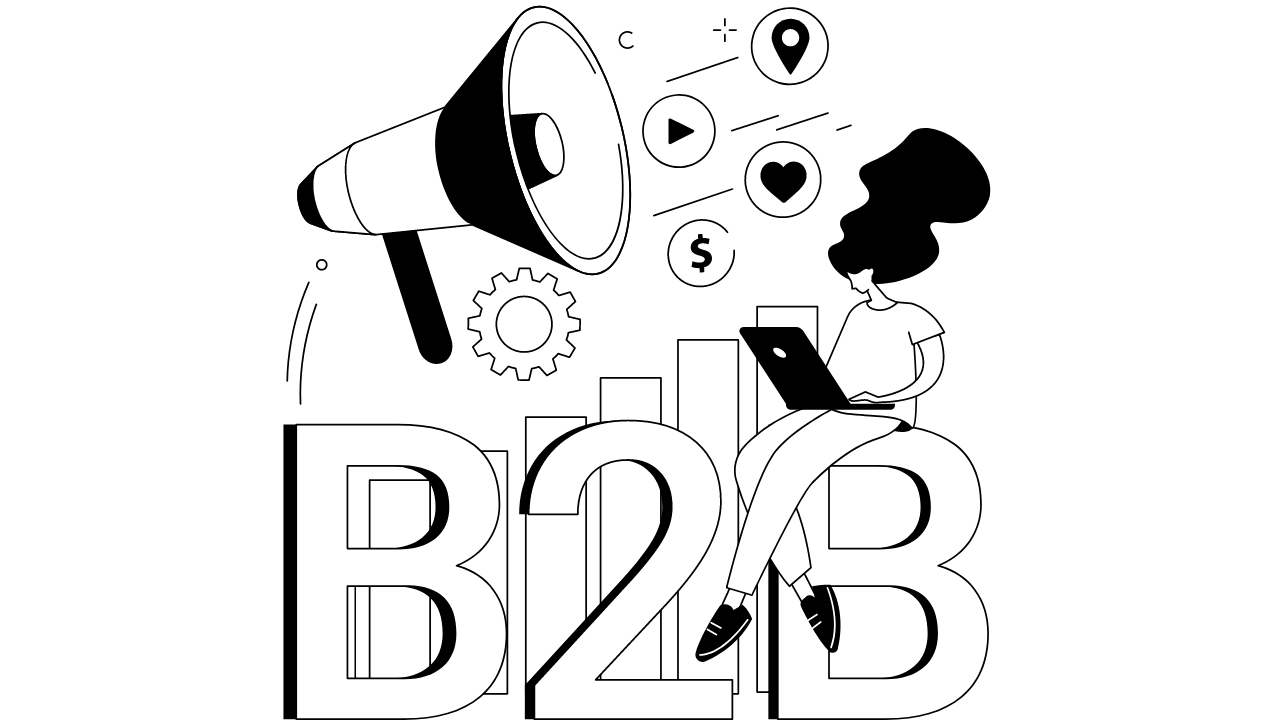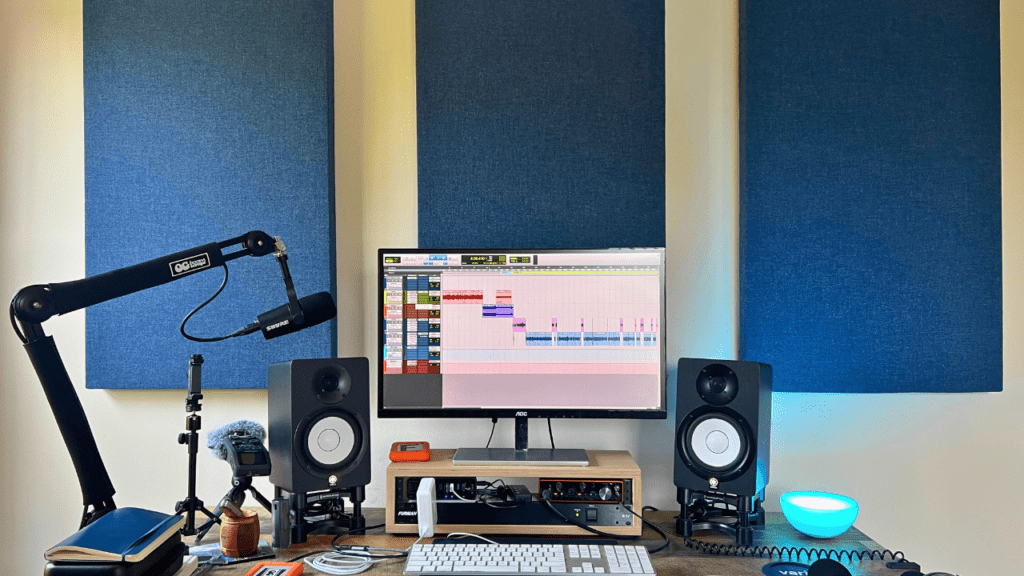
In the business world, staying ahead of the curve is paramount. As a podcast agency, we’ve seen firsthand how a well-crafted B2B podcast can become a marketing machine, offering unique opportunities to connect with your audience, enhance your brand, and carve out a niche in the bustling marketplace.
But how do you navigate the intricacies of starting a B2B podcast that resonates with your target audience and aligns seamlessly with your brand?
This article will guide you through the process, from understanding your audience and finding your niche, to aligning your podcast with your brand, planning your episodes, and measuring your success.
We’ll delve into the technical aspects, content creation, promotion strategies, and performance tracking, all while keeping your audience’s needs and interests at the forefront.
Your B2B Podcast Audience
The Importance of Defining Your Target Audience
Understanding your audience is the cornerstone of any successful podcast. It’s not just about knowing who they are, but understanding their needs, interests, and how they engage with content.
When you define your target audience, you’re not just creating a demographic profile. You’re building a roadmap to podcast success.
This roadmap guides your content creation, helping you to meet listener needs and interests. It’s about more than just age or job title; it’s about understanding their challenges, their motivations, and what they value in a B2B podcast.
Identifying the Needs of your Audience
Identifying the needs and interests of your audience is a critical step in creating a B2B podcast that resonates.
Start by conducting audience research.
Surveys, interviews, and social media listening can provide valuable insights into what your audience wants from a podcast. Look for trends and common themes in their responses.
These are your clues to understanding listener preferences and how to meet their needs. Remember, a successful B2B podcast is one that caters to its audience’s interests, providing value and meeting their needs with each episode.
Case Studies of Successful B2B Podcasts
Let’s look at some successful B2B podcasts and how they cater to their target audience. Radically Transparent and Behind the Post are two highly-rated B2B podcasts that have mastered the art of audience engagement.
They’ve done this by understanding their audience’s needs and delivering content that meets those needs.
The Customer Experience Podcast and Baby Steps (Produced By The Podcast Haven) are other great examples. They’ve identified their audience’s interests and created content that resonates with those interests.
These case studies show that understanding your audience and catering to their needs is a key factor in the success of a B2B podcast.

Finding Your Niche in B2B Podcasting
The Riches Are in The Niches
In the vast ocean of podcasts, finding a unique niche is like discovering an uncharted island. It’s a place where your podcast can stand out, free from the noise of the crowded mainstream.
A unique niche not only sets your podcast apart but also attracts a dedicated audience. This audience, though perhaps smaller, is often more engaged and loyal.
They’re seeking the specific content you’re providing, content they can’t find elsewhere. This is the power of unique podcasting and niche marketing.
It’s not about being everything to everyone, but being something special to those who matter most: your audience.
Researching and Identifying Potential Niches
Finding your niche in B2B podcasting is a journey of exploration. It begins with research. Dive into the B2B market.
Clearly, this is going to be based on your the type of work a company does. Look for gaps, unmet needs, or underrepresented sectors.
These are your potential niches. Listen to other B2B podcasts.
What are they covering? More importantly, what aren’t they covering? These are opportunities for your podcast to fill a void and serve a unique audience.
Remember, identifying B2B niches is not about following the crowd, but forging your own path.
Examples of Niche B2B Podcasts
Let’s look at some examples of successful niche B2B podcasts. Confessions Of A B2B Marketer and Business Growth Show are two podcasts that have found their unique niches and are thriving.
They’ve done this by identifying a specific aspect of B2B marketing and focusing their content around it. Copyblogger FM is another examples of a podcast that has carved out its own niche in the B2B space.
They’ve identified a unique angle, catered to a specific audience, and created content that resonates with that audience. These examples show that finding your niche in B2B podcasting is not just possible, but a proven strategy for success.
Brand Alignment
The Importance of Brand Consistency
Brand consistency is the heartbeat of any successful marketing strategy, and podcasting is no exception. When your podcast aligns with your brand, it becomes an extension of your business, a voice that speaks your brand’s language.
It’s about more than just logos and color schemes. It’s about the message you convey, the values you uphold, and the experience you deliver.
Maintaining brand consistency in your podcast ensures that your audience receives a unified and coherent message, strengthening your brand identity and fostering trust and loyalty among your listeners.

Photo by CHUTTERSNAP on Unsplash
Creating a Podcast Style Guide
A podcast style guide is a powerful tool for maintaining brand consistency. It’s a blueprint that outlines your brand’s voice, tone, and visual elements in the context of your podcast. It guides your content creation, ensuring that every episode reflects your brand.
When creating your style guide, consider your brand’s personality, your audience, and the message you want to convey.
Include guidelines for your podcast’s format, language style, and visual elements. Remember, a podcast style guide is not a set of rigid rules, but a flexible framework that helps you reflect your brand in your podcast.
Case Studies of Well-Branded Podcasts
Let’s look at some well-branded podcasts and how they maintain brand consistency. Inside Trader Joe’s is a podcast that has successfully aligned their content with their brand. They’ve done this by maintaining a consistent voice, tone, and visual style that reflects their brand identity.
LIPSTORIES by Sephora Collection is another example of a well-branded podcast. They’ve managed to create a unique podcast experience that is unmistakably aligned with their brand.
These case studies show that maintaining brand consistency in your podcast is not just about aesthetics, but about creating a cohesive brand experience that resonates with your audience.
Planning Your B2B Podcast
Choosing Your Podcast Format
Choosing the right format for your B2B podcast is like choosing the right vehicle for a journey. It needs to fit your style, your audience, and your content. There are several formats to consider.
Solo podcasts allow you to share your expertise directly with your audience. Co-hosting can bring dynamic conversations and varied perspectives.
Interview formats provide fresh insights from different guests each week. Roundtable discussions can stimulate engaging debates and discussions.
Documentary-style podcasts offer a mix of highly produced content, while fiction podcasts tell a story.
The best format for your B2B podcast depends on your brand, your audience, and your content. Remember, the right format can enhance your podcast design and make your content more engaging.
Developing a Publishing Schedule
A consistent publishing schedule is like a promise to your listeners. It tells them when they can expect new content and helps build anticipation. When creating your schedule, consider your audience’s habits and preferences.
When are they most likely to listen? How frequently do they expect new episodes?
Once you’ve determined this, create a content calendar. This will help you plan your episodes in advance and maintain regular publishing.
Remember, consistency is key in podcasting. It helps build listener loyalty and keeps your audience coming back for more.
Setting Clear Measurable Goals
Setting clear, measurable goals for your podcast is like setting a destination for a journey. It gives you a direction and helps you measure your progress.
Start by defining what success looks like for your podcast. Is it a certain number of downloads? A specific level of listener engagement?
Once you’ve defined your goals, make sure they’re measurable. Use podcast analytics to track your progress and adjust your strategy as needed. Remember, clear goals not only guide your podcasting journey but also help you measure your podcast’s success.
The Technical Aspects of B2B Podcasting
Choosing the Right Equipment and Software
When it comes to starting a B2B podcast, having the right podcast equipment and software is crucial. The quality of your audio can make or break your podcast, so investing in a good microphone is a must.
There are many options available, from USB microphones that are easy to use and relatively affordable, to XLR microphones that offer superior audio quality. Headphones are also essential for monitoring your audio while recording and editing.

In terms of software, you’ll need a reliable recording and editing program.
Audacity is a popular choice due to its user-friendly interface and comprehensive editing tools. It’s also free, making it a great option for those on a budget. Other options include Adobe Audition, GarageBand, and ProTools, which offer more advanced features.
If you prefer to edit by text, Riverside.fm and Descript are great choices. If you sign up for Riverside.fm, use promo code CLIPPED for 20% any individual membership plan.
Remember, the best equipment and software for you will depend on your specific needs and budget. Take the time to research and choose the tools that best suit your podcasting goals.
Creating Engaging B2B Content
Planning Your Podcast Episodes
Planning your podcast episodes is a critical step in creating engaging content. I’ve found that a well-structured plan can make the difference between an average episode and a truly captivating one.
Start by defining the goal of each episode.
What do you want your listeners to learn? What action do you want them to take after listening?
Next, create an outline for each episode. This should include the main points you want to cover, any questions you want to ask (if you’re interviewing a guest), and key takeaways for your listeners. Remember, the goal is to provide value to your audience, so make sure your content is relevant and informative.
Finally, consider the flow of your episode. A good podcast episode, like a good story, has a beginning, middle, and end. Start with an introduction that hooks your listeners, followed by the main content, and wrap up with a conclusion that reinforces the key takeaways.
Feel like a lot of work? That’s because it is!
If you’re smart, you’ll hire a podcast producer to handle all the tasks related to the creation of your show.
Interviewing Guests on Your B2B Podcast
Interviewing guests on your B2B podcast can provide immense value to your audience. Guests bring fresh perspectives, expert insights, and interesting stories that can enrich your content and engage your listeners.
But how do you find and interview guests that will resonate with your B2B audience?
Start by identifying potential guests who are experts in your niche. These could be industry leaders, authors, or even customers who have unique experiences to share.
Reach out to them with a personalized invitation, explaining why you think they would be a great fit for your podcast.
When it comes to the interview itself, preparation is key. Research your guest and their area of expertise, and prepare thoughtful questions that will spark engaging conversations.
Remember, the goal is to provide value to your audience, so focus on topics that are relevant and interesting to them.
Launching a B2B Podcast
Creating a Launch Promotion Plan
Creating a podcast promotion plan for your B2B podcast launch is a crucial step in ensuring your podcast’s success. This process involves several key steps, each contributing to the overall effectiveness of your podcast marketing and launch strategy.
You’ll need to determine your unique value proposition (UVP). Your UVP is a statement that describes the benefits you offer, how you solve a prospect’s needs, and the unique attributes that set you apart from the competition.
Once you have a clear understanding of your audience and UVP, you can begin planning your promotional activities.
This could include social media marketing, email marketing, partnerships with other podcasts or influencers, and even paid advertising. Remember, the goal is to reach your target audience where they are most likely to engage with your content.
Another important aspect of your promotion plan is consistency. Ensure that you have a regular publishing schedule and stick to it. This will help build anticipation among your audience and keep them coming back for more.
Finally, don’t forget to ask your listeners for reviews. Reviews can significantly boost your podcast’s visibility and credibility. Encourage your listeners to leave a review at the end of each episode, and consider offering incentives for those who do.
Remember, creating a podcast promotion plan is not a one-time task. It requires ongoing effort and adjustment based on the feedback and engagement you receive from your audience. Keep track of what works and what doesn’t, and don’t be afraid to try new strategies.
Cross-Promotion Strategies
Cross-promotion is a powerful tool for expanding your podcast audience. It involves partnering with other podcasts or platforms to promote each other’s content.
Here are some tips for setting up successful cross-promotions:
- Identify potential partners: Look for other podcasts or platforms that share a similar audience but offer different content. This way, you can provide additional value to your listeners without promoting direct competition.
- Offer value: When approaching potential partners, make sure you have something valuable to offer. This could be a guest appearance on your podcast, a mention in your show notes, or a shared social media post.
- Be clear about expectations: Before entering into a cross-promotion agreement, make sure both parties understand what is expected. This includes the specifics of the promotion, the timeline, and any other relevant details.
- Track results: After the cross-promotion, track the results to see how effective it was. This can help you refine your strategy for future cross-promotions.
Cross-promotion strategies can significantly expand your podcast audience and increase your reach. By partnering with other shows or platforms, you can tap into their audience and introduce your content to a wider range of listeners.
Measuring B2B Success
Key Performance Indicators (KPIs) for B2b Podcasts
When it comes to measuring the success of your B2B podcast, it’s crucial to focus on the right Key Performance Indicators (KPIs). These are measurable values that can help you understand how well your podcast is performing in relation to your business objectives.
One of the most important KPIs for a B2B podcast is the number of unique listeners. This metric gives you an idea of how many individuals are tuning into your podcast.
Another crucial KPI is the number of subscribers and downloads, which can help you gauge the growth and popularity of your podcast.
Rankings and reviews are also essential KPIs to consider. High rankings on podcast platforms can increase your visibility and attract more listeners. Positive reviews, on the other hand, can boost your credibility and encourage more people to listen to your podcast.
Social sharing is another KPI that can indicate the success of your B2B podcast.
If your listeners are sharing your podcast episodes on their social media platforms, it means they find your content valuable and worth sharing with their network.
Tools for Tracking Podcast Performance
To effectively track these KPIs, you’ll need the right tools. There are several podcast analytics tools available that can provide you with detailed insights into your podcast’s performance.
Blubrry is a popular tool that offers podcast hosting, publishing, and analytics. It can provide you with detailed statistics about your podcast’s performance, including the number of downloads, listener demographics, and more.
Podtrac is another excellent tool that provides accurate audience data. It offers a unique monthly audience metric that can give you a clear picture of your podcast’s reach.
Chartable is a comprehensive podcast analytics tool that can track your rankings on podcast platforms, monitor your reviews, and provide insights into your listeners’ behavior.
Transistor, Castos, and Podbean are other notable tools that can help you track your podcast’s performance and understand your audience better. Each tool has its unique features, so it’s essential to choose one that fits your specific needs and goals.
Remember, the key to a successful B2B podcast lies in understanding your audience and delivering valuable content consistently.
By focusing on the right KPIs and using the appropriate tools, you can measure your success and continuously improve your podcast.
B2B Podcast Wrap Up
In the journey of creating a successful B2B podcast, understanding your audience, finding your niche, aligning your podcast with your brand, and planning your content are key steps. The technical aspects can’t be overlooked, and creating engaging content is paramount.
Promoting your podcast effectively is crucial to reach a wider audience, and measuring success through KPIs and analytics tools helps in continuous improvement.
Each step is a piece of the puzzle that, when put together, forms the picture of a successful B2B podcast.
By following these guidelines, you’re well on your way to creating a podcast that not only resonates with your target audience but also stands out in the crowded podcasting landscape.
References
- “Podcast Statistics (2023) – [Infographic].” MusicOomph. Link
- “How to Start a Podcast: Every Single Step for 2023.” The Podcast Host. Link
- “The Best Podcast Equipment for Starters and Enthusiasts.” The Podcast Host. Link
- “Podcast Metrics: How to Measure Your Podcast’s Success.” Castos. Link
- “The 10 Best Podcast Apps in 2023.” The Podcast Host. Link
- “The Top 10 Business Podcasts of 2023.” Forbes. Link
- “How to Promote Your Podcast: The 2023 Ultimate Guide.” Buzzsprout. Link
- “How to Create a Podcast Style Guide.” Pacific Content. Link
- “How to Identify Your Target Audience for Your Podcast.” Wistia. Link
- “How to Find Your Podcast Niche.” Podcast.co. Link
To Learn More How to Start, Grow and Monetize a Podcast Signup For Our Weekly Newsletter
Contact Form Home
Follow The Podcast Haven On Social Media
Listen To Clipped – A Podcast Haven Original
Check Out Our Blog Archive
- Focusrite Scarlett: The Best Audio Interfaces For Podcasting
- Yamaha HS5: Excellent Monitors For Editing Podcasts
- Maono PD200X: A Multifunctional Microphone
- How To Grow Your Podcast
